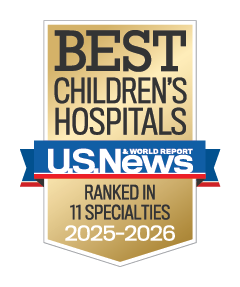

In 1986, pediatric hematologist-oncologist Katherine Matthay, MD, performed the first therapy of 131I-metaiodobenzylguanidine (131I-MIBG) in a pediatric neuroblastoma patient at UCSF – one of the earliest such treatments in the U.S.1 Convinced of its potential as a novel treatment strategy for neuroblastoma, Dr. Matthay and her colleagues pioneered the use of therapeutic MIBG to hone in on and directly deliver therapeutic radiation to neuroblastoma cells in patients with difficult-to-treat disease.
Thanks to the persistence and expertise of Dr. Matthay and other pioneers in the field of neuroblastoma biology and clinical trial development, targeted agents and biomarkers have advanced the field of neuroblastoma care. Today, that work continues through novel clinical trials developed and overseen by Kieuhoa Vo, MD, a pediatric hematologist-oncologist at UCSF Benioff Children’s Hospitals.2

“The groundbreaking research at UCSF has changed the face of neuroblastoma care,” said Dr. Vo, who trained under Dr. Matthay and is now director of the early-phase clinical trials program in pediatric oncology and the MIBG therapy program for neuroblastoma and other neuroendocrine tumors at UCSF Benioff Children’s Hospitals. “We have a robust, extensive portfolio of neuroblastoma clinical trials that attracts many patients seeking access to new, targeted molecular therapies and immunotherapies otherwise unavailable outside of a clinical trial for neuroblastoma.”
Collaborative work and innovation
Unfortunately, even now, there are few curative therapies available for children with neuroblastoma whose disease does not respond to front-line therapy. In patients with difficult-to-treat neuroblastoma, previous studies showed that the response rate to single-agent MIBG therapy is approximately 20 to 40%. To build on this single-agent activity, numerous early-phase trials developed by UCSF researchers and through cooperative groups, including New Approaches in Neuroblastoma Therapy (NANT), are investigating combination strategies incorporating MIBG.
NANT is an early-phase clinical trial consortium originally established by Dr. Matthay in 2000 and is focused on developing new agents in phase 1 and 2 trials for patients with relapsed and refractory neuroblastoma. Dr. Vo is pushing that work forward, and by 2025 will launch a new NANT clinical trial to study the effects of combination MIBG therapy. By using MIBG in concert with immunotherapy strategies, such as targeted anti-GD2 antibodies, Dr. Vo hopes to improve outcomes in patients with neuroblastoma.2 As MIBG therapy hasn’t yet achieved approval from the Food and Drug Administration, access to the treatment is only possible through clinical trials, many of which are available at UCSF Benioff Children’s Hospitals.
“Our program also allows us to facilitate the translation of new drugs being investigated in our rich pipeline of laboratories here at UCSF to patients in the clinic, with the ultimate goal of improving outcomes in pediatric oncology,” Dr. Vo said.
UCSF neurologist William Weiss, MD, PhD, developed the first genetic mouse model for spontaneous neuroblastoma that is now widely used to study pathologic origins and new targeted therapies for the disease. Collaborations involving Dr. Weiss and experts in nuclear medicine have also facilitated the development of new combination therapies to synergize with MIBG.
Combined efforts with a singular goal
Alongside world-class clinical and translational science, UCSF Benioff Children’s Hospitals bring together a team of specialists to ensure all patients with neuroblastoma receive optimal care along their journey. As they move the understanding of neuroblastoma forward, Dr. Vo and her colleagues in oncology, bone marrow transplant, surgery, radiation oncology and nuclear medicine bring together their clinical expertise in order to treat the disease. With one of the only pediatric neuroblastoma programs in Northern California, UCSF Benioff Children’s Hospitals are high-referral centers for children in and near the region.
“Nearly 50% of all patients with high-risk neuroblastoma relapse, necessitating better therapies,” Dr. Vo said. “Our program is providing critical access to new anticancer drugs for children and young adults with advanced neuroblastoma who desperately need new therapies. Some of the promising drugs tested in our trials may become the foundation of future treatments in the frontline setting for patients with newly diagnosed neuroblastoma.”
Dr. Vo’s statement encapsulates the end goal of most research on neuroblastoma care: seeking to improve upfront therapy and finding more effective treatments when disease returns. Forging ahead with new trials, whether developed in-house or via Children's Oncology Group and NANT, is the primary means of reaching this goal.
Seeking the keys to long-term success
In the past few decades, researchers have made strides in uncovering best practices for neuroblastoma care, yet the disease still holds mysteries that keep them pushing for more answers. Of the unknowns, Dr. Vo emphasizes a few questions whose answers would have a significant effect on neuroblastoma care in the future. These questions include:
- Why do certain patients initially respond to therapy only to relapse in the future?
- Are there biomarkers that identify a patient’s likelihood to respond or fail to respond to certain therapies?
- What causes tumors to develop resistance mechanisms, and how do those mechanisms function?
These basic questions are the foundations of ongoing research efforts, and Dr. Vo suspects that finding the answers may take decades. Until then, researchers remain focused on understanding the underpinnings of neuroblastoma and developing novel approaches to therapy.
"We always strive for more effective, less toxic therapy with limited long-term side effects,” Dr. Vo said. “We’re making great strides, but we’re not quite there yet. We’ve made numerous improvements in survival in an upfront setting against advanced neuroblastoma, but these are questions we are still working on and will continue to do so in the future.”
Do you have a patient who could benefit from our neuroblastoma care? Refer a patient online or call the Pediatric Access Center at (877) 822-4453 (877-UC-CHILD).
______________________________________________________________________
1 https://neuroblastoma.ucsf.edu/mibg-therapy-high-risk-neuroblastoma-ucsf-0
2 Interview with Dr. Vo
3 https://kidshealth.org/en/parents/mibg.html and confirmed with additional sources: https://www.snmmi.org/AboutSNMMI/Content.aspx?ItemNumber=35208 and https://www.cancer.org/cancer/types/neuroblastoma/treating/radiation-therapy.html and https://www.ucsfbenioffchildrens.org/treatments/high-risk-neuroblastoma-treatment-options



